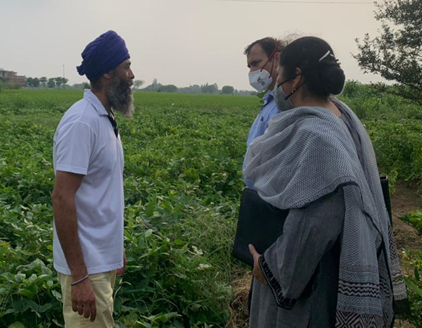By Suveera Gill and Amanjot Kaur


Have you ever thought about whether the food you eat as ‘organic’ is grown organically? Growing organics ‘organically’ requires concerted effort, time and investment on the part of the farmer. Mr. Ramnik Singh, the owner of the Khaalis Natural Farm, shared his journey of connecting with nature and love to eat and deliver healthy and nutritious food. According to him, the first three years for an organic farmer are the most challenging. Farmers must not use prohibited substances, such as synthetic fertilizers, sewage solids, insecticides, herbicides, or fungicides, to the land and not grow genetically modified organisms. For obtaining organic certification, they must further prove that they are truly walking their talk to an official certification agency initially and on a regular basis thereafter.
Teeming Biodiversity
Stepping on Khaalis Natural Farm was like stepping into teeming biodiversity – with animals, birds, bees, butterflies, earthworms and ants. Organic food is grown in harmony with nature, with organic farmers being its custodians. In contrast to conventional chemical farming, organic cultivation sustains the soil, air, water and ecosystem.

Natural fields and the absence of pesticides and insecticides create suitable habitats for species at the ecosystem level resulting in their growth both in number and variety. Organic farmers tend to nurture their field in a traditional way of agriculture, using minimal tilling, organic seeds, cover crops, crop rotation, intercropping, farmyard, and natural control methods creating suitable conditions for soil fauna and flora. Natural soil fertility is a prerogative in organic systems. The integrated crop-tree-animal system creates a suitable habitat for humanity as a whole.
Nurturing the Food Chain
Many microbes, insects and birds that we think of as pests are nurturers of the organic food chain. Mr. Ramnik believes that organic systems strengthen natural disease resistance and pest predation. The preservation of natural areas of vegetation adjacent to crops and plants provide alternative food and sanctuary to many insect predators, wild flora, birds and other wildlife. Planting large trees on the periphery of the farmland provides a natural shield against hazardous drifts. They also provide important nesting, feeding and sheltering sites for birds, thus enhancing farmland birds that pick on insects and worms in the field.


Growing legumes on a rotation basis fix atmospheric nitrogen and improve soil health while increasing biodiversity as pollinators. Many bees, beetle, and butterfly species are pollinators that are so crucial in natural plant communities. The fodder crops and grains are grown as livestock and poultry feed change the soil food web composition, augmenting the earthworm population. Earthworms work as soil biotechnologists and solid waste managers leading to improved soil fertility. Further, the animal and bird feed waste and excreta are excellent farmyard manure as they supply plant nutrients, including micronutrients. Organic farms are thus an intricate web of life.

” Once you associate with the soil, nature becomes your principal teacher. It teaches you to discover joy and pleasure from simple things in life”. Mr. Ramnik
Conclusion
Sipping on a perfectly brewed firewood tea with a dash of fresh buffalo milk unravelled the perfect balance between nature and humans, way away from our own parochial lifestyles. As we left the farm, the cock crowed, reminding us that roosters do crow at dusk. So why don’t you grab an opportunity to do a reality check yourself?

Nce
LikeLike